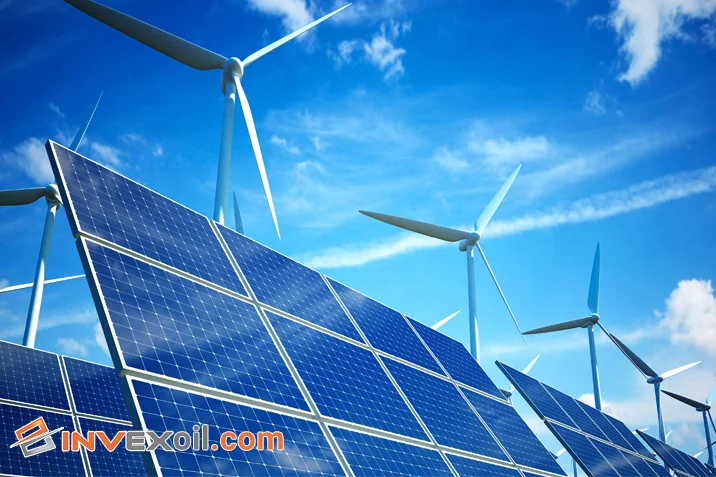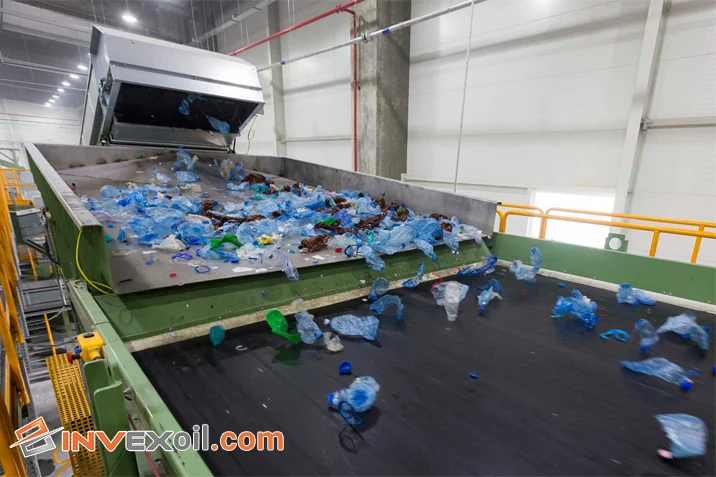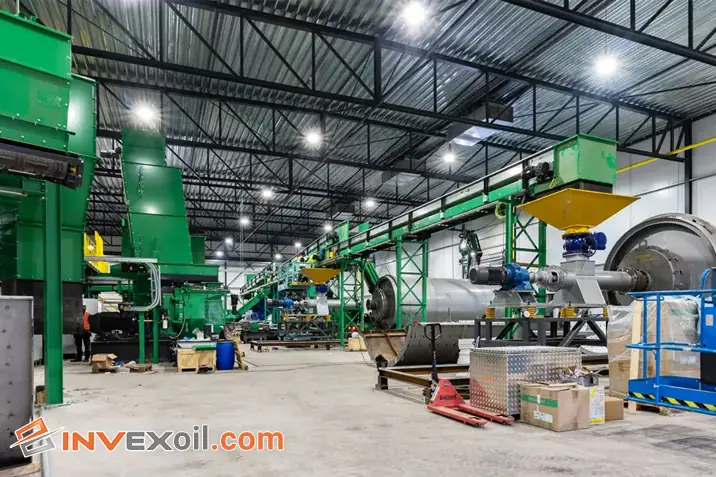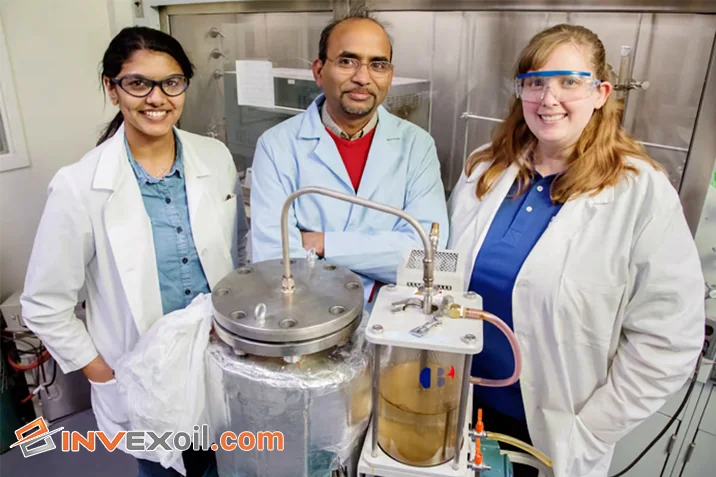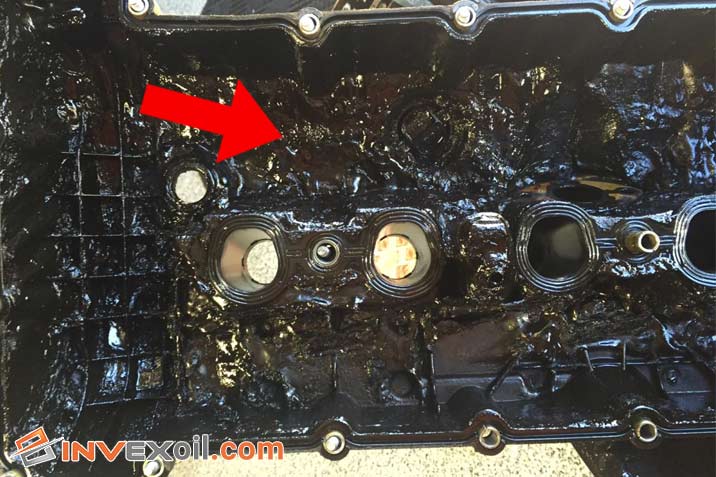Is Converting Plastic Waste into Fuel the game-changer in sustainable energy solutions? The world is drowning in plastic waste, and our traditional disposal methods are no longer viable. This article dissects the innovative process of transforming plastic waste into diesel fuel, a revolutionary step towards an eco-friendly future.
In this comprehensive guide from InvexOil, we will explore the intricacies of this transformation, from the basics of plastic waste recycling to the advanced chemical and mechanical recycling techniques. Follow us to the end.
Table of Contents
Basics of Plastic Waste Recycling
Plastic waste recycling plays a pivotal role in mitigating the environmental impact of plastic waste. It involves reprocessing plastic waste into new and valuable products, significantly reducing the need for virgin plastic production and conserving natural resources. There are two primary methods of recycling plastic: mechanical recycling and chemical recycling.
Mechanical recycling, a more commonly used method, involves physically breaking down plastic waste into smaller pellets that can be reused to make new plastic products. This method is widely applied for recycling types of plastic like PET and HDPE, which are known for their versatility and durability.
Chemical recycling, on the other hand, breaks down plastic waste into its molecular components. These components can then produce new plastics or as an energy source. This method is particularly effective for plastics that are difficult to recycle mechanically.
Another significant aspect of waste management is the oil recycling process. This process is critical in minimizing waste, as used oil can be collected and re-refined into new products, reducing the demand for fresh oil. This conserves resources and prevents the potential pollution caused by improper disposal of used oil.
Table: Comparison of Different Plastic Recycling Methods
| Method | Description | Advantages | Disadvantages |
| Chemical recycling | It breaks down plastic into its chemical components, which can be used to make new plastic products. | It is more sustainable than landfilling or incineration. Can produce a higher-quality product than mechanical recycling. | It is less developed than mechanical recycling and more expensive. |
| Mechanical recycling | Grinds up plastic waste and then melts and reshapes it into new products. | The most common and affordable recycling method. Can produce a wide variety of products. | It can contaminate recycled plastic with impurities, which can reduce its quality. |
| Incineration | Burns plastic waste to generate energy. | It can reduce the amount of plastic waste going to landfills. It can generate electricity or heat. | Produces air pollution and harmful emissions. |
The Process of Converting Plastic to Fuel: Step by Step
In today’s world, Converting Plastic Waste into Fuel offers a promising solution to the dual challenges of waste management and energy sustainability. This process addresses the environmental crisis and taps into chemical and mechanical recycling potential. Let’s break down this process into comprehensive steps:
Step 1: Collection and Sorting of Plastic Waste
The journey begins with the meticulous collection and sorting of plastic waste. This step is fundamental to ensure the quality and efficiency of the fuel conversion process. Different plastics like PET, HDPE, and PVC, each with unique properties, are segregated. The used oil recycling process can also be integrated here to manage any oil-contaminated plastics.
Step 2: Pre-treatment and Preparation
Once sorted, the plastic undergoes pre-treatment. This includes cleaning to remove impurities and shredding to create a uniform feedstock. The aim is to prepare the plastic for efficient processing, making it easier to transform into fuel.
Step 3: Pyrolysis – The Core Process
Pyrolysis, the core of the process, involves heating the plastic in an oxygen-free environment. This breaks down the long polymer chains into more minor hydrocarbon gases and liquids. It’s a vital step in chemical recycling, converting plastic waste into a valuable resource.
Step 4: Condensation and Refining
The gases produced during pyrolysis are then condensed into a liquid form. This crude oil-like liquid is further refined, similar to traditional petroleum refining, to make different types of fuels, including diesel. This step highlights the efficiency of converting waste into a resourceful commodity.
Step 5: Quality Testing and Storage
The final step involves quality testing of the produced fuel to ensure it meets industry standards. This includes checking for purity, density, and other properties. Once approved, the energy is stored safely and ready for distribution and use, marking a successful end to the plastic waste recycling and conversion journey.
Table: Steps in the Plastic-to-Fuel Conversion Process
| Step | Description |
| Collection | Plastic waste is collected from various sources, such as households, businesses, and landfills. |
| Processing | The plastic waste is sorted, cleaned, and shredded. |
| Pyrolysis | The shredded plastic is heated in a closed chamber without oxygen. |
| Gasification | The pyrolysis products are further processed to produce syngas, a carbon monoxide and hydrogen mixture. |
| Fuel production | The syngas is then converted into diesel fuel using a Fischer-Tropsch process. |
Advanced Methods in Plastic to Fuel Conversion
The transformation of plastic waste into fuel has seen remarkable advancements, especially in the field of chemical recycling. Innovative methods are continuously being developed to enhance the efficiency and sustainability of this process. For instance:
- Catalytic Pyrolysis: This method uses catalysts to lower the temperature required for the pyrolysis process, making it more energy-efficient.
- Microwave-Assisted Pyrolysis: Utilizing microwave radiation, this technique speeds up the decomposition of plastic waste, leading to faster fuel production.
- Gasification: An alternative to pyrolysis, gasification converts plastic waste into syngas, a versatile fuel source.
These advanced methods are crucial in optimizing Converting Plastic Waste into Fuel, thereby contributing to waste reduction and energy recovery. They represent a significant leap forward in addressing the environmental crisis caused by plastic waste.
Environmental Impact of Plastic Waste
The accumulation of plastic waste in our environment has far-reaching impacts. Let’s break down these effects:
- Soil and Water Pollution: Plastics leaching chemicals into soil and water bodies disrupt ecosystems and contaminate resources.
- Wildlife Threats: Marine and terrestrial animals often ingest or get entangled in plastic waste, leading to fatal consequences.
- Carbon Footprint: The production and decomposition of plastics contribute significantly to greenhouse gas emissions.
The concept of Converting Plastic Waste into Fuel not only helps mitigate these environmental impacts but also transforms a pollutant into a valuable resource. This approach aligns with sustainable practices like mechanical recycling and incineration, providing a viable solution to the global environmental crisis. We are moving towards a more sustainable and cleaner future by turning waste into energy.
Table: Challenges of Converting Plastic Waste into Fuel
| Challenge | Description |
| Cost | The conversion process is expensive. |
| Technology | The technology for converting plastic waste into fuel is still developing. |
| Infrastructure | There is insufficient infrastructure to collect and process plastic waste for conversion into fuel. |
Case Studies: Successful Implementations of Plastic to Fuel Conversion
Converting Plastic Waste into Fuel has been a game-changer in waste management and energy production worldwide. Here are some successful examples:
- United States: Large-scale facilities in the Midwest are turning plastic waste into diesel, significantly reducing landfill burdens.
- Japan: Pioneering advanced chemical recycling technologies, Japan efficiently converts plastic waste into various fuel types, setting a global standard.
- Netherlands: Dutch initiatives focus on integrating mechanical recycling and pyrolysis processes, showcasing innovative circular economy models.
These cases highlight the potential of plastic waste recycling to contribute to an environmental crisis solution while creating valuable energy resources.
The Role of Incineration in Waste Management
Incineration plays a significant role in managing waste, especially where recycling options are limited. It involves burning waste materials at high temperatures, reducing volume, and generating energy. However, it’s essential to balance it with environmental considerations:
- Efficiency: While incineration can convert around 30-40% of waste into energy, Converting Plastic Waste into Fuel through pyrolysis or gasification can yield higher energy recovery rates.
- Environmental Impact: Incineration may lead to emissions of dioxins and other pollutants, whereas fuel conversion technologies are often designed to minimize such emissions.
Comparing incineration with plastic-to-fuel conversion methods reveals that the latter offers a more sustainable and efficient approach to waste management, aligning with global efforts to tackle the environmental crisis.
Table: Different Types of Plastic Waste
| Type of Plastic | Examples |
| PET | Soda bottles, water bottles, food containers |
| HDPE | Milk jugs, shampoo bottles, detergent bottles |
| PVC | Pipes, window frames, siding |
| LDPE | Grocery bags, bread bags, frozen food packaging |
| PP | Yogurt containers, meat trays, cups |
| PS | Styrofoam, disposable plates and cups, packing peanuts |
Process of Making Diesel Fuel from Plastic
Converting Plastic Waste into Fuel, specifically diesel, is a fascinating process using advanced chemical recycling techniques. Here’s a simplified overview:
- Collection and Sorting: Gather various plastic wastes, emphasizing plastic waste recycling.
- Preparation: Clean and shred the plastic into smaller pieces.
- Pyrolysis: Heat the plastics in an oxygen-free environment, breaking them into smaller hydrocarbon chains.
- Distillation: Refine the pyrolysis oil into diesel.
- Quality Enhancement: Add additives to improve the quality of the diesel.
Challenges include dealing with mixed plastic types and ensuring environmental safety. Innovations in mechanical recycling and catalytic processes are proving effective in addressing these issues, making the used oil recycling process more efficient and eco-friendly.
Conclusion
In this insightful journey through Converting Plastic Waste into Fuel, we’ve navigated the transformative process from plastic waste recycling to diesel fuel production. In this article from Invexoil, we’ve seen the integration of methods like chemical and mechanical recycling, the crucial role of pyrolysis, and the environmental significance of this innovative approach. This article educates and empowers with actionable knowledge, from understanding the used oil recycling process to tackling the ecological crisis.
FAQ
What is the Basic Process of Converting Plastic Waste into Diesel Fuel?
The process involves collecting and sorting plastic waste, treating it through pyrolysis to break down the polymers, condensing the vapors into a liquid form, and refining it into diesel fuel. This innovative method offers an effective solution to manage plastic waste.
How Does Chemical Recycling Differ from Mechanical Recycling?
Chemical recycling breaks down plastic waste into its chemical components, often converting it into fuel or new plastics. In contrast, mechanical recycling physically processes plastics into new materials without altering their chemical structure.
Can All Types of Plastic Waste be Converted into Diesel Fuel?
Not all plastics are suitable for conversion into diesel fuel. Typically, high-density polyethylene (HDPE) and polyethylene terephthalate (PET) are most efficiently converted, while others may not be as viable due to their chemical composition.
What Role Does Pyrolysis Play in Converting Plastic to Fuel?
Pyrolysis is the central process in converting plastic waste to fuel. It involves heating the plastic in an oxygen-free environment and breaking down the long polymer chains into smaller hydrocarbon gases, condensing them into liquid fuel.
How Does Converting Plastic Waste into Fuel Impact the Environment?
This conversion helps mitigate environmental pollution by reducing plastic waste in landfills and oceans. It also provides an alternative energy source, potentially reducing reliance on fossil fuels and lowering greenhouse gas emissions.

Hello, This is Matteo Hudson Copywriter from InvexOil. We are here to provide super-important content to help you learn more easily and be involved in the world of Petroleum and Chemistry. We are here to answer your questions, help you to have better services, and also find the best solution for your problems. Don’t be shy and ask your questions in the comment box or call our number. If you want to connect with me directly, you can search for my name on Linkedin.


